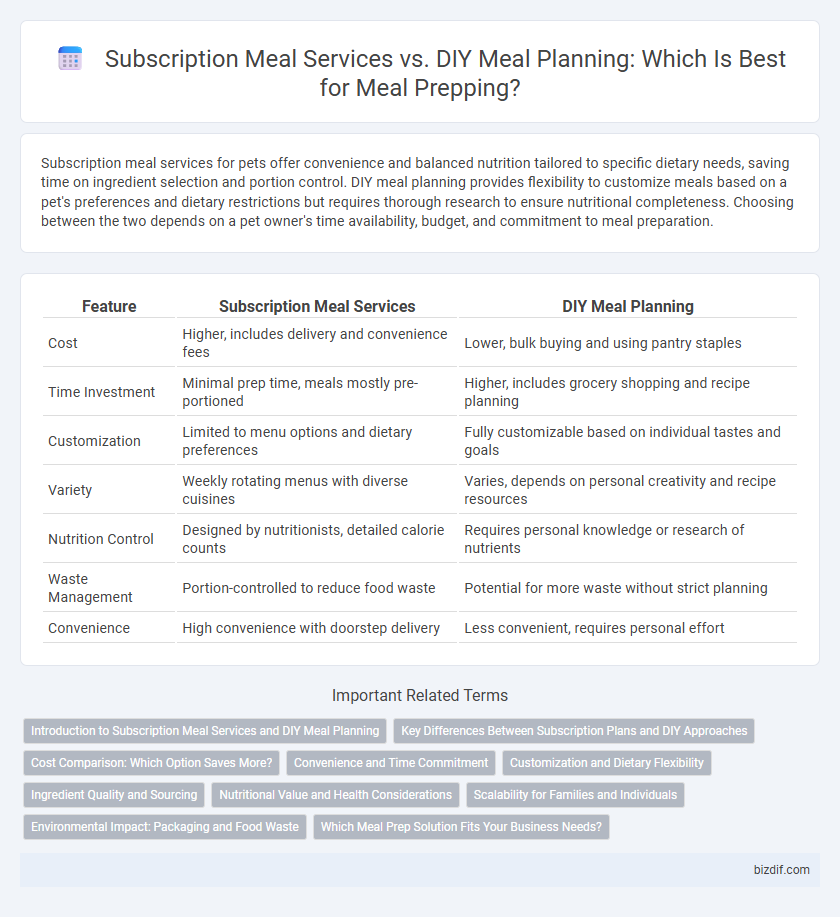Subscription meal services for pets offer convenience and balanced nutrition tailored to specific dietary needs, saving time on ingredient selection and portion control. DIY meal planning provides flexibility to customize meals based on a pet's preferences and dietary restrictions but requires thorough research to ensure nutritional completeness. Choosing between the two depends on a pet owner's time availability, budget, and commitment to meal preparation.
Table of Comparison
| Feature | Subscription Meal Services | DIY Meal Planning |
|---|---|---|
| Cost | Higher, includes delivery and convenience fees | Lower, bulk buying and using pantry staples |
| Time Investment | Minimal prep time, meals mostly pre-portioned | Higher, includes grocery shopping and recipe planning |
| Customization | Limited to menu options and dietary preferences | Fully customizable based on individual tastes and goals |
| Variety | Weekly rotating menus with diverse cuisines | Varies, depends on personal creativity and recipe resources |
| Nutrition Control | Designed by nutritionists, detailed calorie counts | Requires personal knowledge or research of nutrients |
| Waste Management | Portion-controlled to reduce food waste | Potential for more waste without strict planning |
| Convenience | High convenience with doorstep delivery | Less convenient, requires personal effort |
Introduction to Subscription Meal Services and DIY Meal Planning
Subscription meal services offer curated, ready-to-cook meal kits delivered regularly, eliminating the need for grocery shopping and detailed meal planning. DIY meal planning involves selecting recipes, purchasing ingredients, and preparing meals independently, allowing for complete control over dietary preferences and budget. Both methods aim to streamline weekly meal routines but cater to different levels of convenience and customization.
Key Differences Between Subscription Plans and DIY Approaches
Subscription meal services offer convenience through pre-portioned ingredients and ready-to-follow recipes, saving time on grocery shopping and meal planning. DIY meal planning allows for greater flexibility and customization based on personal dietary preferences, budget constraints, and portion sizes, but requires more effort and time investment. Cost comparison typically favors DIY planning, while subscription plans provide consistent meal variety and reduce food waste through precise ingredient delivery.
Cost Comparison: Which Option Saves More?
Subscription meal services often have higher upfront costs due to convenience fees and premium ingredient sourcing, averaging around $8 to $12 per serving. DIY meal planning tends to save money by bulk purchasing and minimizing food waste, with costs typically ranging from $3 to $6 per meal depending on grocery choices. However, hidden expenses such as time spent grocery shopping and meal preparation should be factored into the overall cost comparison.
Convenience and Time Commitment
Subscription meal services offer unparalleled convenience by delivering pre-portioned ingredients or fully prepared meals directly to your door, significantly reducing grocery shopping and cooking time. DIY meal planning requires a larger time investment upfront for researching recipes, creating shopping lists, and meal prepping, which may be less convenient for busy individuals. Choosing between these depends on balancing the desire for control over ingredients and cost-efficiency against the priority of minimizing daily meal preparation time.
Customization and Dietary Flexibility
Subscription meal services offer tailored meal plans that cater to specific dietary needs such as keto, vegan, or gluten-free, providing convenience through pre-portioned ingredients and chef-curated recipes. DIY meal planning allows greater customization by enabling individuals to select ingredients, control portion sizes, and adjust recipes to fit unique preferences or fluctuating dietary requirements. Both approaches support dietary flexibility, but DIY planning offers more control over ingredient sourcing and meal variety, while subscription services ensure time-efficient, nutritionally balanced options.
Ingredient Quality and Sourcing
Subscription meal services often source high-quality, fresh ingredients from local farms and trusted suppliers, ensuring consistent freshness and sustainability. DIY meal planning allows for personalized ingredient selection, often prioritizing organic and specialty products based on individual preferences and dietary needs. Comparing both, subscription services streamline access to premium ingredients, while DIY planning offers control over sourcing transparency and ingredient origin.
Nutritional Value and Health Considerations
Subscription meal services offer nutritionally balanced meals designed by dietitians, ensuring portion control and diverse micronutrient intake tailored to various health goals. DIY meal planning allows for personalized ingredient selection, enabling control over dietary restrictions, ingredient freshness, and macronutrient distribution, but requires nutrition knowledge to avoid imbalances. Both methods affect nutritional value and health considerations, with subscription plans favoring convenience and consistency, while DIY offers customization and potential cost savings.
Scalability for Families and Individuals
Subscription meal services offer scalable meal planning solutions that cater to both families and individuals by providing customizable portion sizes, diverse menu options, and flexible delivery schedules. DIY meal planning demands significant time investment to scale effectively, requiring organization and adaptation to varying nutritional needs and preferences across family members. For families seeking convenience and variety, subscription services streamline scalability, while individuals focused on cost control and personal dietary requirements often prefer the flexibility of DIY approaches.
Environmental Impact: Packaging and Food Waste
Subscription meal services often generate significant packaging waste due to single-use containers and excessive plastic, which can increase environmental impact compared to DIY meal planning. DIY meal planning enables better control over ingredient quantities, reducing food waste by tailoring portions to individual needs and minimizing leftovers. Sustainable practices, such as using reusable containers and buying bulk ingredients, further decrease the ecological footprint associated with meal preparation.
Which Meal Prep Solution Fits Your Business Needs?
Subscription meal services offer streamlined convenience with pre-portioned ingredients and ready-made recipes, ideal for businesses seeking to save time and reduce waste. DIY meal planning provides flexibility and cost control, allowing companies to tailor menus to specific dietary requirements and ingredient preferences. Choosing the right meal prep solution depends on your business priorities such as budget, customization needs, and operational efficiency.
Subscription Meal Services vs DIY Meal Planning Infographic

 bizdif.com
bizdif.com